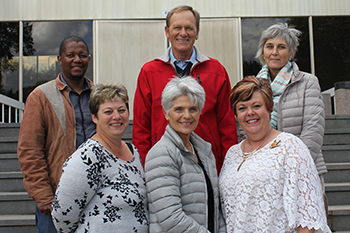
Back row; from left; John Keitsemore from
Bartimea School for the Deaf; Philip Cook,
the headmaster at De la Bat School for the
Deaf in Worcester; Jeannie Cook, De la Bat School
for the Deaf; front, from left; Marisa Vermeulen, mother
of two deaf children and teacher at Bartimea
School for the Deaf in Thaba Nchu; Marianne Kühn,
audiologist, and Susan Lombaard, acting Head of the
Department of South African Sign Language.
Photo: Rulanzen Martin
“Ninety percent of deaf children are born into hearing families. When parents first receive the news, they are shocked, angry and confused,” says Susan Lombaard, Acting head of the Department of South African Sign Language at the University of the Free State (UFS).
The department hosted a workshop, “Early intervention options for the child with a hearing loss”, on Friday 12 May 2017 on the Bloemfontein Campus. “It is the first time a sign language workshop of this kind was hosted by the Department of South African Sign Language at the UFS,” says Lombaard, who facilitated the workshop. They hope to make it an annual event.
Parents of deaf children do not always know how they will communicate with their children or where the child must attend school. The workshop aimed to provide parents with the necessary information on different communication options and also touched on school placement.
Support group for parents established
A support group for parents was also established, the first of its kind in the province. It will provide much-needed support, information and guidance for parents of deaf children.
Some of the speakers at the workshop included Anri Esterhuizen, an audiologist; Marianne Kühn from the Carel du Toit Centre, Marisa Vermeulen, who is a mother of two deaf children, and Phillip Cook, the headmaster at De la Bat School for the Deaf in Worcester, in the Western Cape. Jeannie Cook, also a presenter, provided information on sign language acquisition of the small deaf child, which is done through creative play.
Professionals have responsibility
South African Sign Language is a language in its own right and is not international. “Sign language is a visual language with its own grammar and syntax different from spoken language,” Lombaard said.
There has been much controversy surrounding teaching deaf children to speak and teaching them to sign. “We as professionals have the responsibility to provide information on all options. This is to help the parent make informed decisions about communication and school placement.”